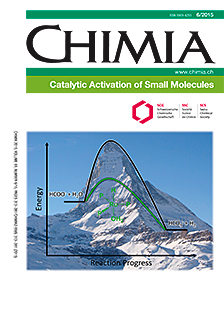Effect of 2-Propanol on the Transfer Hydrogenation of Aldehydes by Aqueous Sodium Formate using a Rhodium(I)-sulfonated Triphenylphosphine Catalyst
DOI:
https://doi.org/10.2533/chimia.2015.339Keywords:
Aldehydes, Rhodium-phosphine catalyst, Sodium formate, Transfer hydrogenation, WaterAbstract
In water/2-propanol mixtures [RhCl(mtppms)3] (mtppms = monosulfonated triphenylphosphine) was an efficient catalyst for the selective C=C reduction of trans-3-phenyl-2-propenal (trans-cinnamaldehyde) by hydrogen transfer from formate at temperatures as low as 30 °C. An outstandingly high catalyst turnover frequency of 1214 h–1 was determined at 70 °C. A possible mechanism of the reaction is suggested on the basis of kinetic studies and 1H- and 31P-NMR spectroscopic identification of the major Rh(I) species in the reaction mixtures as cis-mer-[H2RhX(mtppms)3] (X = HCOO– or H2O). It was established that a large part but not all of the rate increase observed in water/2-propanol mixtures in comparison with systems with neat water as solvent was the consequence of complete dissolution of trans-cinnamaldehyde on the effect of the co-solvent. Nevertheless, the rate showed a significant further increase with increasing 2-propanol concentration even in homogeneous solution and this was ascribed to changes in the solvent structure. The high catalyst activity in this solvent mixture allowed the transfer hydrogenation of citral. Although good to excellent conversions were observed at 30–70 °C, a useful degree of selectivity in hydrogenation of C=C vs. C=O bonds could not be achieved.Downloads
Published
2015-06-24
Issue
Section
Scientific Articles
License
Copyright (c) 2015 Swiss Chemical Society

This work is licensed under a Creative Commons Attribution-NonCommercial 4.0 International License.
How to Cite
[1]
Chimia 2015, 69, 339, DOI: 10.2533/chimia.2015.339.







